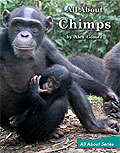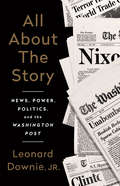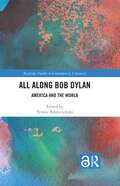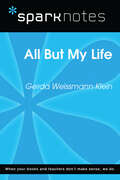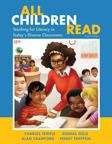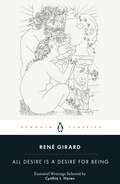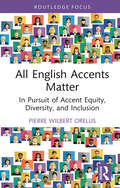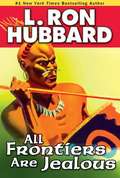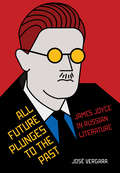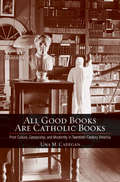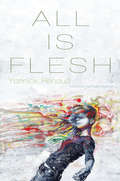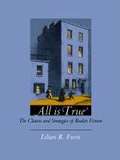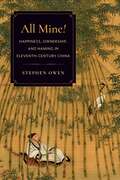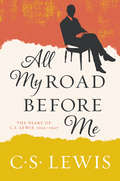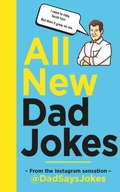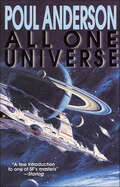- Table View
- List View
All About Boats (Fountas & Pinnell LLI Green #Level H, Lesson 106)
by Stanley FrancisFountas and Pinnell Leveled Literacy Intervention Green System -- 1st Grade
All About Chimps (Fountas & Pinnell LLI Green #Level H, Lesson 108)
by Alex GomezFountas and Pinnell Leveled Literacy Intervention Green System -- 1st Grade
All About Dolphins (Fountas & Pinnell LLI Green #Level J, Lesson 103)
by Katcha DiazFountas and Pinnell Leveled Literacy Intervention Green System -- 1st Grade
All About Honeybees (Fountas & Pinnell LLI Green #Level I, Lesson 99)
by Jerry AlbertFountas and Pinnell Leveled Literacy Intervention Green System -- 1st Grade
All About Nature: Animals, Insects, Plants, and More! (The All About Picture Book Series)
by Huda HarajliDiscover the world outside—an introduction to nature for kids ages 3 to 5Can you feel the sun? Hear the birds singing? See colorful leaves on the trees? That's nature! This picture book of fun facts teaches preschool and kindergarten kids all about land, water, air, and critters big and small. Watch them discover their inner explorer as they look for different kinds of rocks, spot stars in the sky, and learn to love the great outdoors.Our amazing planet—Find out why it gets dark at night, meet some interesting insects, and explore how people are a part of nature, too.Illustrations everywhere—Every page is bursting with vibrant artwork of objects in nature and other kids celebrating the world around them.Vocabulary building—Check out a list of nature words and their definitions to help little ones understand all the amazing new things they've learned.Get this amazing nature book for kids today and see what makes exploring nature so much fun!
All About the Story: News, Power, Politics, and the Washington Post
by Leonard Downie JrAt a time when the role of journalism is especially critical, the former executive editor of the Washington Post writes about his nearly fifty years at the newspaper and the importance of getting at the truth.In 1964, as a twenty-two-year-old Ohio State graduate with working-class Cleveland roots and a family to support, Len Downie landed an internship with the Washington Post. He would become a pioneering investigative reporter, news editor, foreign correspondent, and managing editor, before succeeding the legendary Ben Bradlee as executive editor.Downie's leadership style differed from Bradlee's, but he played an equally important role over more than four decades in making the Post one of the world's leading news organizations. He was one of the editors on the historic Watergate story and drove coverage of the impeachment of President Bill Clinton. He wrestled with the Unabomber's threat to kill more people unless the Post published a rambling 30,000-word manifesto and he published important national security stories in defiance of presidents and top officials. He managed the Post's ascendency to the pinnacle of influence, circulation, and profitability, producing prizewinning investigative reporting with deep impact on American life, before the digital transformation of news media threatened the Post's future.At a dangerous time, when health and economic crises and partisanship are challenging the news media, Downie's judgment, fairness, and commitment to truth will inspire anyone who wants to know how journalism, at its best, works.
All Along Bob Dylan: America and the World (Routledge Studies in Contemporary Literature)
by J. Roger KurtzAll Along Bob Dylan: America and the World offers an important contribution to thinking about the artist and his work. Adding European and non-English speaking contexts to the vibrant field of Dylan studies, the volume covers a wide range of topics and methodologies while dealing with the inherently complex and varied material produced or associated with the iconic artist. The chapters, organized around three broad thematic sections (Geographies, Receptions and Perspectives), address the notions of audience, performance and identity, allowing to map out the structure of feeling and authenticity, both, in the case of the artist and his audience. Taking its cue from the collapse of the so-called high-/ low culture split following from the Nobel Prize, the book explores the argument that Dylan (and all popular music) can be interpreted as literature and offers discussions in the context of literary traditions, or visual culture and music. This contributes to a nuanced and complex portrayal of the seminal cultural phenomenon called Bob Dylan.
All But My Life (SparkNotes Literature Guide Series)
by SparkNotesAll But My Life (SparkNotes Literature Guide) by Gerda Weissmann Klein Making the reading experience fun! Created by Harvard students for students everywhere, SparkNotes is a new breed of study guide: smarter, better, faster. Geared to what today's students need to know, SparkNotes provides: *chapter-by-chapter analysis *explanations of key themes, motifs, and symbols *a review quiz and essay topics Lively and accessible, these guides are perfect for late-night studying and writing papers.
All Children Read: Teaching For Literacy In Today's Diverse Classrooms (Fourth Edition)
by Donna Ogle Charles A. Temple Alan N. Crawford Penny FrepponWritten by one of the most dynamic author teams in the field of Reading and Literacy, the Fourth Edition of All Children Read continues to offer K-8 teachers the best practices for developing reading and writing in all students. The new edition integrates Common Core State Standards, deepens its exploration of Response to Intervention (RTI), looks more deeply at comprehension of informational text, and emphasizes the teaching of English Language Learners. Central to, and woven throughout, this text are the six overriding themes-the struggling reader; family/community literacy; new literacies; writing and reading connections; developmental, cultural, and linguistic diversity; and phonics/phonological awareness. This title is also available packaged with the Enhanced Pearson eText. To order the Enhanced Pearson eText packaged with a bound book, use ISBN 0133388204.
All Desire is a Desire for Being
by René GirardA new selection of foundational works from the influential philosopher who developed the theory of mimetic desireWhy do humans have such a remarkable capacity for conflict? From ancient foundational myths to the modern era, the visionary thinker Rene Girard identified the constant, competing desires at the heart of our existence - desires that we copy from others, igniting a contagious violence. This remarkable and accessible new selection of Girard's work shows him as a writer for our times, as he ranges over human imitation and rivalry, herd behaviour, scapegoating and how our violent longings play out in stories, from Shakespeare to religion. 'The explosion of social media, the resurgence of populism, and the increasing virulence of reciprocal violence all suggest that the contemporary world is becoming more and more recognizably "Girardian" in its behaviour' The New York Review of BooksEdited with an Introduction by Cynthia L. Haven
All Desires Known
by Janet MorleyA classic and indispensable resource for public worship and private devotion that speaks to people across a range of traditions - both within and beyond the church. Composed in response to the desire for worship language of worship that's inclusive of women's experience yet deeply rooted in the words, stories, and images of Scripture, they have resonated not only with women, but with all who love the Bible and who want to pray with honesty and directness. <P><P> This new edition introduces a fresh selection of material on themes of global justice, as well as a contemporary Eucharist and prayers that coincide with the Revised Common Lectionary.
All Ears: The Aesthetics of Espionage
by Peter SzendyThe world of international politics has recently been rocked by a seemingly endless series of scandals involving auditory surveillance: the NSA’s warrantless wiretapping is merely the most sensational example of what appears to be a universal practice today. What is the source of this generalized principle of eavesdropping?All Ears: The Aesthetics of Espionage traces the long history of moles from the Bible, through Jeremy Bentham’s “panacoustic” project, all the way to the intelligence-gathering network called “Echelon.” Together with this archeology of auditory surveillance, Szendy offers an engaging account of spycraft’s representations in literature (Sophocles, Shakespeare, Joyce, Kafka, Borges), opera (Monteverdi, Mozart, Berg), and film (Lang, Hitchcock, Coppola, De Palma). Following in the footsteps of Orpheus, the book proposes a new concept of “overhearing” that connects the act of spying to an excessive intensification of listening. At the heart of listening Szendy locates the ear of the Other that manifests itself as the originary division of a “split-hearing” that turns the drive for mastery and surveillance into the death drive.
All English Accents Matter: In Pursuit of Accent Equity, Diversity, and Inclusion (Routledge Studies in Sociolinguistics)
by Pierre Wilbert OrelusOrelus' valuable study draws on the scholarly work of sociocultural and postcolonial theorists, as well as testimonies collected from study participants, to explore accentism, the systemic form of discrimination against speakers whose accents deviate from a socially constructed norm. Orelus examines the manner in which accents are acquired and the effects of such acquisition on the learning and educational experiences of linguistically and culturally diverse students. He goes on to demonstrate the ways and the degree to which factors such as race, class, and country of origin are connected with nonstandard accent-based discrimination. Finally, this book proposes alternative ways to challenge and counter the accentism that minority groups, including linguistically and culturally diverse groups, have faced in schools and in society at large. It will be of interest to all of those concerned with linguistic/accent-based prejudice and the experience of those who face it.
All Frontiers Are Jealous
by L. Ron HubbardExplore this larger than life tale. American engineer Dan Courtney is surveying the route of the Sudan Railway in Africa, linking the Uganda Railway with the Anglo-Egyptian Railroad--a project that seems doomed to fail.When he finds that a young American woman has been kidnapped by the most feared tribe on the continent, the Dinkas, it lands him in an action-swept, life-or-death confrontation to save the girl. The battle with the Dinkas will determine not only the fate of the railway system, but reveal the identity of a killer stalking the girl. "...the stories' fast-moving pace is sure to keep listeners enthralled. Great fun for nostalgia buffs, recommended for tweens and up." --Library Journal
All Future Plunges to the Past: James Joyce in Russian Literature (NIU Series in Slavic, East European, and Eurasian Studies)
by José VergaraAll Future Plunges to the Past explores how Russian writers from the mid-1920s on have read and responded to Joyce's work. Through contextually rich close readings, José Vergara uncovers the many roles Joyce has occupied in Russia over the last century, demonstrating how the writers Yury Olesha, Vladimir Nabokov, Andrei Bitov, Sasha Sokolov, and Mikhail Shishkin draw from Joyce's texts, particularly Ulysses and Finnegans Wake, to address the volatile questions of lineages in their respective Soviet, émigré, and post-Soviet contexts. Interviews with contemporary Russian writers, critics, and readers of Joyce extend the conversation to the present day, showing how the debates regarding the Irish writer's place in the Russian pantheon are no less settled one hundred years after Ulysses.The creative reworkings, or "translations," of Joycean themes, ideas, characters, plots, and styles made by the five writers Vergara examines speak to shifting cultural norms, understandings of intertextuality, and the polarity between Russia and the West. Vergara illuminates how Russian writers have used Joyce's ideas as a critical lens to shape, prod, and constantly redefine their own place in literary history.All Future Plunges to the Past offers one overarching approach to the general narrative of Joyce's reception in Russian literature. While each of the writers examined responded to Joyce in an individual manner, the sum of their methods reveals common concerns. This subject raises the issue of cultural values and, more importantly, how they changed throughout the twentieth century in the Soviet Union, Russian emigration, and the post-Soviet Russian environment.
All Good Books Are Catholic Books: Print Culture, Censorship, and Modernity in Twentieth-Century America
by Una M. CadeganUntil the close of the Second Vatican Council in 1965, the stance of the Roman Catholic Church toward the social, cultural, economic, and political developments of the twentieth century was largely antagonistic. Naturally opposed to secularization, skeptical of capitalist markets indifferent to questions of justice, confused and appalled by new forms of high and low culture, and resistant to the social and economic freedom of women—in all of these ways the Catholic Church set itself up as a thoroughly anti-modern institution. Yet, in and through the period from World War I to Vatican II, the Church did engage with, react to, and even accommodate various aspects of modernity. In All Good Books Are Catholic Books, Una M. Cadegan shows how the Church’s official position on literary culture developed over this crucial period.The Catholic Church in the United States maintained an Index of Prohibited Books and the National Legion of Decency (founded in 1933) lobbied Hollywood to edit or ban movies, pulp magazines, and comic books that were morally suspect. These regulations posed an obstacle for the self-understanding of Catholic American readers, writers, and scholars. But as Cadegan finds, Catholics developed a rationale by which they could both respect the laws of the Church as it sought to protect the integrity of doctrine and also engage the culture of artistic and commercial freedom in which they operated as Americans. Catholic literary figures including Flannery O’Connor and Thomas Merton are important to Cadegan’s argument, particularly as their careers and the reception of their work demonstrate shifts in the relationship between Catholicism and literary culture. Cadegan trains her attention on American critics, editors, and university professors and administrators who mediated the relationship among the Church, parishioners, and the culture at large.
All Is But a Beginning: Youth Remembered, 1881-1901
by John G. NeihardtJohn Neihardt, celebrated for his cycle of epic poems about the American West and for Black Elk Speaks, was in his nineties when he wrote this engaging book about growing up in the Midwest. All Is But a Beginning describes the people and events instrumental in shaping his later distinguished career as a poet; historian, and authority on Indians.
All Is Flesh
by Hugh Hazelton Yannick RenaudAll Is Flesh collects in one volume Hugh Hazelton's English translations of Yannick Renaud's brilliant first two books of poems, Taxidermy and The Disappearance of Ideas, first published by Éditions Les Herbes rouges in Montreal.Taxidermy is a discourse on time consisting of prose poems stretched to the very limits of detachment. A completely objectified couple, alternately speaking as simply "he" or "she," strive to attain perfect control over their physical movements. Slowing them down, even stopping them, is equivalent in their minds to seizing and savouring the essence of the present and, by extension, to stopping time in their lives-an enactment of the romantic aesthetics of Keats's "Ode on a Grecian Urn." Their attempts at "holding the pose," as much for themselves as for each other, generate a tension in their voices-at once demanding, yearning and confessional-between the need for both static form and fluid movement in the choreography of their lives, which seeks to "occupy space unequivocally."The Disappearance of Ideas is a meditation on time that interrogates death and mourning, reminding us that "death remains the privilege of the living" and that "cathedrals tell us nothing more than the time on their stones." Unsentimental and intellectualized, the poems generate their radiant intensity by drawing our attention to the part of mourning that remains unresolved and inaccessible in our memories, reminding us of "what we don't know of stories." But this absence, what remains unknown of the past to us, also haunts our futures, where "actions taken only hinder what should have been," and "there is no second chance." As Baudrillard has said: "Things live only on the basis of their disappearance, and, if one wishes to interpret them with entire lucidity, one must do so as a function of their disappearance."
All Is True: The Claims and Strategies of Realist Fiction
by Lilian R. Furst"All is true," realist writers would say of their work, to which critics now respond: All is art and artifice. Offering a new approach to reading nineteenth-century realist fiction, Lilian R. Furst seeks to reconcile these contradictory claims. In doing so, she clarifies the deceptions, appropriations, intentions, and ultimately the power of literary realism.In close textual analyses of works ranging across European and American literature, including paradigmatic texts by Balzac, Flaubert, George Eliot, Zola, Henry James, and Thomas Mann, Furst shows how the handling of time, the presentation of place, and certain narrational strategies have served the realists' claim. She demonstrates how readers today, like those a hundred years ago, are convinced of the authenticity of the created illusion by such means as framing, voice, perspective, and the slippage from metonymy to metaphor. Further, Furst reveals the pains the realists took to conceal these devices, and thus to protect their claim to be employing a simple form. Taking into account both the claims and the covert strategies of these writers, All Is True puts forward an alternative to the conventional polarized reading of the realist text--which emerges here as neither strictly an imitation of an extraneous model nor simply a web of words but a brilliantly complex imbrication of the two.A major statement on one of the most enduring forms in cultural history, this book promises to alter not only our view of realist fiction but our understanding of how we read it.
All Mine!: Happiness, Ownership, and Naming in Eleventh-Century China
by Stephen OwenUnder the Song Dynasty, China experienced rapid commercial growth and monetization of the economy. In the same period, the austere ethical turn that led to neo-Confucianism was becoming increasingly prevalent in the imperial bureaucracy and literati culture. Tracing the influences of these trends in Chinese intellectual history, All Mine! explores the varied ways in which eleventh-century writers worked through the conflicting values of this new world.Stephen Owen contends that in the new money economy of the Song, writers became preoccupied with the question of whether material things can bring happiness. Key thinkers returned to this problem, weighing the conflicting influences of worldly possessions and material comfort against Confucian ideology, which locates true contentment in the Way and disdains attachment to things. In a series of essays, Owen examines the works of writers such as the prose master Ouyang Xiu, who asked whether tranquility could be found in the backwater to which he had been exiled; the poet and essayist Su Dongpo, who was put on trial for slandering the emperor; and the historian Sima Guang, whose private garden elicited reflections on private ownership. Through strikingly original readings of major eleventh-century figures, All Mine! inquires not only into the material conditions of happiness but also the broader conditions of knowledge.
All My Road Before Me: The Diary of C. S. Lewis, 1922-1927
by C. S. LewisA repackaged edition of the revered author’s diary from his early twenties—a thought-provoking work that reveals his earliest thinking about war, atheism, religion, and humanity.While serving his country in the Great War, C. S. Lewis’ the great British writer, scholar, lay theologian, broadcaster, and Christian apologist—made a pact with a close friend and fellow soldier. If one of them died, the survivor would take care of his family—a promise Lewis honored. Developing a deep friendship with his fallen friend’s mother, Jane King Moore, Lewis moved into the Moore household after the war. Returning to Oxford, the twenty-three-year old Lewis—then a staunch atheist—struggled to adapt to life in post-war England. Eager to help the tormented young man, Jane encouraged him keep a diary of his day-to-day life. Those reflections are collected in this illuminating journal. Covering five remarkable years in Lewis's life, All My Road Before Me charts the inspirations and intellectual and spiritual development of a man whose theology and writing—including Mere Christianity, The Screwtape Letters, The Great Divorce, The Chronicles of Narnia, and many other beloved classics—has had immense influence on the Christian world.
All New Dad Jokes: The perfect gift from the Instagram sensation @DadSaysJokes
by Dad Says JokesTHE BRAND-NEW BOOK FROM @DADSAYSJOKESAll New Dad Jokes is the second book from the most followed dad jokes page on Instagram, @DadSaysJokes. Now with a following of over 1 million, All New Dad Jokes provides brand new gags guaranteed to leave your friends and family laughing and groaning in equal measure.@DadSaysJokes is a community-run Instagram account with more than a million followers, inspired by the daily jokes of author Kit Chilvers' dad, Andrew. Every day, followers submit their jokes and the team picks their favourites - or Dad just drops in his own zinger! Kit, a young social networking mastermind started his career at the tender age of 14, when he created his original platform, Football.Newz, to serve audiences for the World cup 2014. He has recently added another nine platforms in different genres (of which @DadSaysJokes is one), with nine million followers and rising. This is his second book. Q: Where do naughty rainbows go?A: Prism.
All New Dad Jokes: The perfect gift from the Instagram sensation @DadSaysJokes
by Dad Says JokesALL NEW CONTENT FROM THE ORIGINAL BESTSELLERAll New Dad Jokes is the second book from the most followed dad jokes page on Instagram, @DadSaysJokes. Now with a following of over 1 million, All New Dad Jokes provides brand new gags guaranteed to leave your friends and family laughing and groaning in equal measure.@DadSaysJokes is a community-run Instagram account with more than a million followers, inspired by the daily jokes of author Kit Chilvers' dad, Andrew. Every day, followers submit their jokes and the team picks their favourites - or Dad just drops in his own zinger! Kit, a young social networking mastermind started his career at the tender age of 14, when he created his original platform, Football.Newz, to serve audiences for the World cup 2014. He has recently added another nine platforms in different genres (of which @DadSaysJokes is one), with nine million followers and rising. This is his second book. Q: Where do naughty rainbows go?A: Prism.
All One Universe: A Collection Of Fiction And Nonfiction
by Poul Anderson“Themes of a colorful assortment of stories range from life on other planets to alternative history . . . a perfect introduction to his perennial genius.” —BooklistPoul Anderson himself has put together a retrospective collection of his recent writings, fiction and nonfiction, under the title All One Universe. This is the first major Poul Anderson collection in a decade. It encompasses all his strengths as a teller of tales and, in addition, provides a running commentary in the story notes and in the essays on other literary figures such as Rudyard Kipling, Johannes B. Jensen, and John W. Campbell, Jr., commentary that illuminates the fiction, gives personal insight into the mind of this fine writer, and provides a unifying personality for All One Universe. All One Universe, then, represents the new best of Poul Anderson. It is a rich, varied selection of quintessential science fiction as well as four essays, mostly from recent years, by one of the great science fiction writers of the century. His stories are filled with roaring energy, the soul of poetry, and dark imaginings.“A fine introduction to one of SF’s masters.” —Starlog“Fact and fiction, shaped by one of SF’s keenest minds, are mingled in this collection . . . On the whole, All One Universe is a collection which does its creator proud while delighting his fans.” —Rapport“Poul Anderson’s writings have been at a remarkably high, consistent level of quality for nearly fifty years, now. All One Universe is a book for anyone interested in either SF or in craftsmanship.” —David Drake

